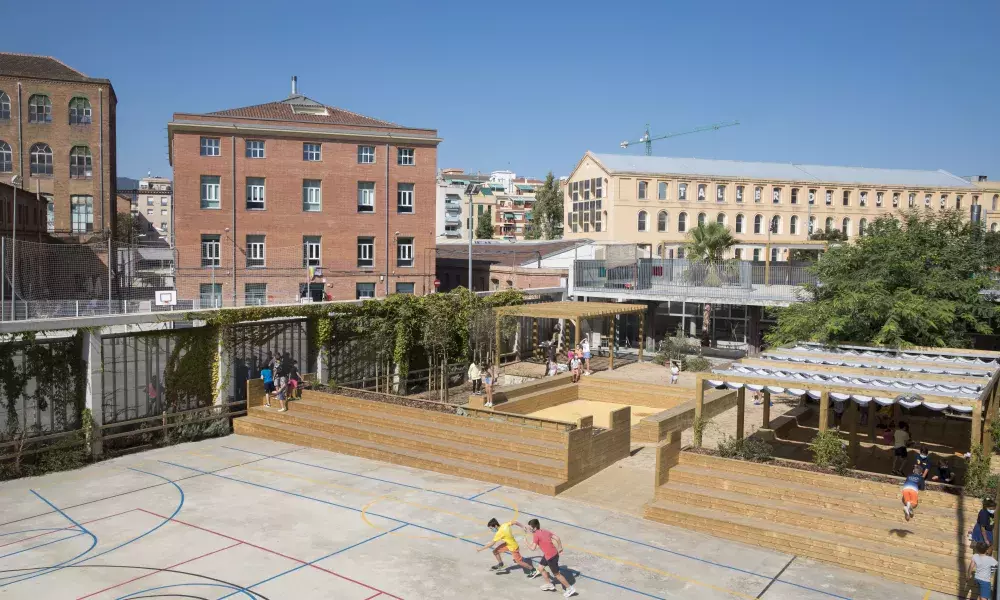
Climate sensitive urban design
Climate change is a phenomenon with implications that crosses physical boundaries and traditional disciplines. Its impact on cities is, among others, reflected by elevated temperatures as well as more frequent and intense heat waves, as is the case for a number of south European cities, including Barcelona.
For a city to adapt to climate change, urban design needs to be innovative and well aligned to new scientific findings which explain the association of heat to meteorological conditions, land cover, urban form and functions.
Climate sensitive urban design recognizes that cities need to adapt to changing environments. Measures can include landscape plans to increase urban greenery and remove heat sources, local water interventions to support evaporation and take advantage of its cooling potential, energy systems to minimize use, cool construction materials to limit the warming up of urban surfaces, shading devices to limit incident solar radiation, etc.
Getting Climate Ready
The City of Barcelona has shown leadership in recognizing the impacts of climate change and making a commitment to adapt to them. By planning to reduce vulnerabilities, build on existing strengths, increase resilience, and minimize the severity of the impacts of climate change, the City of Barcelona can become climate ready, namely to cope with a new (urban) climate reality.
Barcelona has integrated in its overall Climate Adaptation Plan, an innovative pilot project aiming to develop a network of eleven Climate Shelters around the city. The project has a duration of 3 years and is funded by the Urban Innovation Actions (UIA) of the European Commission.
Climate adaptation is an opportunity to drive sustainable urban development by combining synergies between different levels of governments, stakeholders from the public and private sector and local residents
Eleven pilot schools (the buildings and the open yards) have been transformed into Climate Shelters by hosting blue, green and grey interventions. It is worth mentioning that schools are well placed within the neighborhoods of a city thus supporting adaptation to climate change at the local urban scale, whereas their yards can be used for the general public once an extreme event, such as a heat wave, takes place.
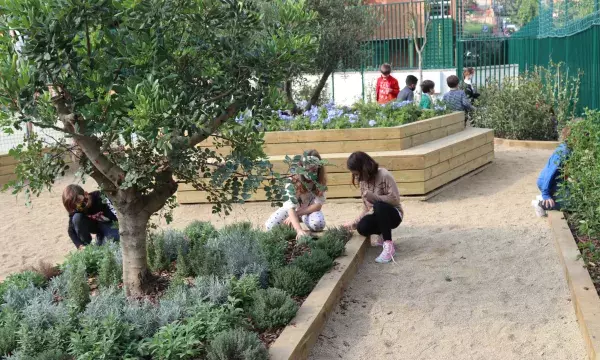
From design to implementation
An important aspect of the Climate Shelters project was to integrate climate adaptation considerations into plans and intervention decisions. To this end, the road map leading from a climate sensitive design to the implementation of the interventions as far as the conversion of the schools to Climate Shelters project is concerned, may be described as follows:
Assess and understand the risks of climate change impacts[1]
Communicate positive messages on climate adaptation, even if the overall theme (climate change and its impacts) is unpleasant[2],
Provide information and tools on climate adaptation to facilitate and accelerate action; Integrate science in policy making[3]
Provide space for participation and collaboration amongst community stakeholders in view of their engagement[4],
Design and implement tailor made interventions for the participating schools
Plan for the financing and long term implementation of adaptive actions,
Develop networks to increase the climate resilience of the city
Continue to plan for efficient response and recovery to climate impacts and finally
Upscale the project in order to maximize benefits.
It should be noted that the implementation plan for the Climate Shelters project was based on a thorough background analysis of the state of the urban environment in Barcelona[5]; in addition it took note of climate change predictions in terms of the temperature field and the presence and strength of heat waves. The project is also reflective of an extensive study of the prevailing environmental conditions[6] at each of the eleven schools and builds on the participative processes, the consultations as well as the feedback received from city officials, science experts, school community partners and key community stakeholders.
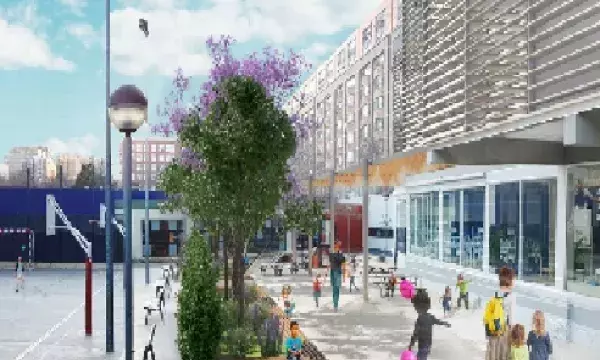
The plan followed a central principle, namely that “One solution does not fit all”, in other words that the interventions designed per school were differentiated so as to take note of the prevailing local urban and environmental conditions per school as well as the specific per school building characteristics. As a matter of fact, the project has developed distinct sets of interventions for each of the eleven schools, as based mostly on green and grey infrastructure and to a lesser extent on blue infrastructure. The average cost of the interventions accounted to roughly 200,000 euros per school, although some deviations to the above amount apply.
The design and implementation phase of the Climate Shelters project lasted from April 2019 to October 2020, although the implementation of the interventions took place in the period July to September 2020, not without difficulties due to the covid-19 pandemic.
The Climate Shelters project may be considered as ‘quick win’ given that it required less than two years to design, deliberate, finalize and implement the interventions for the conversion of the schools to Climate Shelters; it has thus created awareness of the public and boosted the interest of other schools, a fact which facilitates the upscaling phase of the project.
Upon the conversion of the schools, approximately 1,000 square meters of natural land with plants in school playgrounds were reclaimed, replacing concrete ground, and 2,213 square meters of new spaces have been created, shaded by pergolas and awnings. In addition, a total of 74 trees have been planted, equivalent to the number of trees found in two entire blocks in one of the schools’ neighborhood; finally 26 new water points have been installed [7].
Selected case studies
The following three case studies are presented for the schools Poblenou, Can Fabas and Els Llorers; each case study refers to the school environment and the mix of interventions as implemented for the conversion of the schools to Climate Shelters. The artistic plans summarizing the interventions per school are provided along with images demonstrating the state of the school prior and after the interventions, in order to facilitate comparisons.
Case study 1. School Poblenou (Escola Poblenou)
According to the performed analysis[8], the school is exposed to high values of incident solar radiation (Image 1, right) and has limited green cover.
Image 1. View of the Poblenou school (left) and estimate of the exposure to solar radiation (right); yellow and red colors refer to high values.

As a result, and taken that the school was considered highly vulnerable to heat, the suggested interventions for its conversion to Climate Shelter (Image 2) focused on the increase of shading for the school building and the school yard, and the enhancement of greenery, the latter in the school yard.
Image 2. Interventions to be implemented at Poblenou school. 1: solar protection device; 2: new garden and pergola; 3: trees planting 4: pergola (Source: Barcelona City Council – Urban Ecology Area).
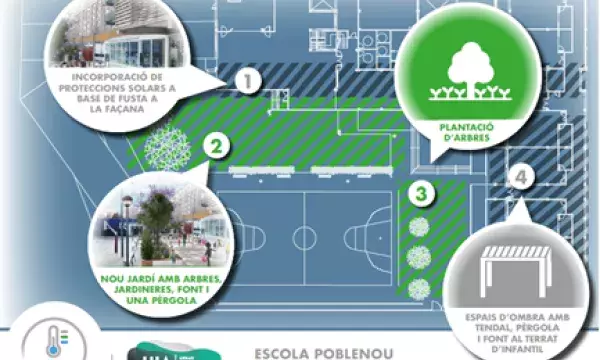
Image 3. Image of the Poblenou school prior (left) and after the interventions (right); see also point 1 of Image 2.
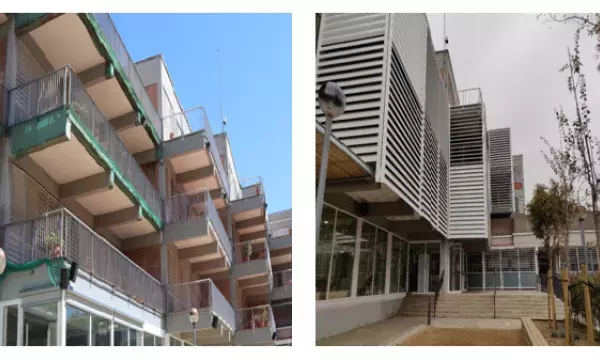
Image 4. Plantation of trees at the school yard.
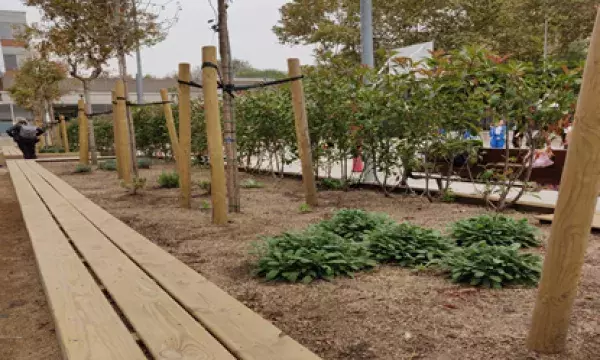
Special consideration was given in the enhancement of greenery in the school yard in an obvious effort to improve the microclimatic conditions and mitigate heat (Image 5).
Image 5. Image of the Poblenou school yard, prior (left) and after the interventions (right); see also point 2 of Image 2.
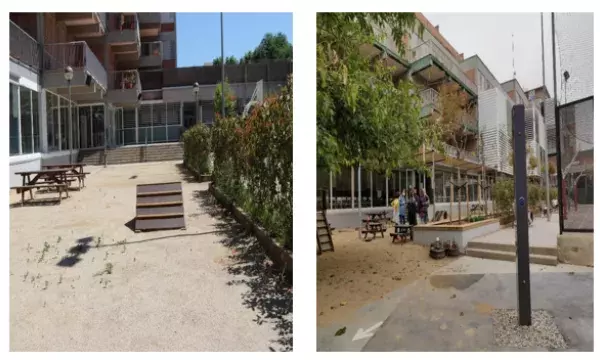
Furthermore a pergola (Image 6; see also point 4 of Figure 2) was constructed at the terrace of the lower building (right part of the building, Image1), in order to serve a dual purpose: (a) to increase shading and thus drop the temperature of the roof and (b) to provide a new open space for the students, with the space being appropriately sheltered from solar radiation and thus heat.
Image 6. Pergola with tent for shade provision.
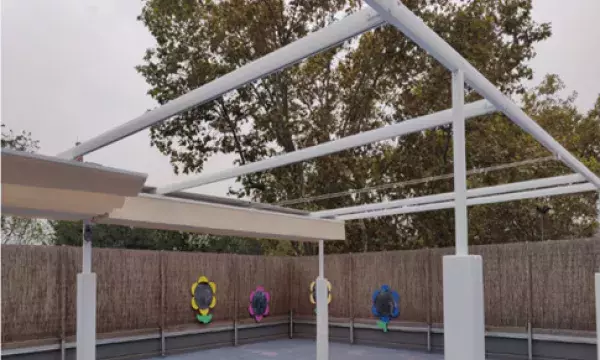
Case study 2 Can Fabra School
According to the performed analysis[9], the school is exposed to high values of incident solar radiation at the school yard (Image 7, right), whereas the school yard is covered to its greater extent with impermeable materials.
Image 7. View of the Can Fabra school (left) and estimate of the exposure to solar radiation (right); yellow and red colors refer to high values.

In order to mitigate heat, the interventions for the conversion of the school to Climate Shelter (Image 8) focused on greenery and shading at the school yard.
Image 8. Interventions to be implemented at Can Fabra school. 1: solar protection device; 2: new garden and pergola; 3: trees planting 4: pergola (Source: Barcelona City Council – Urban Ecology Area).
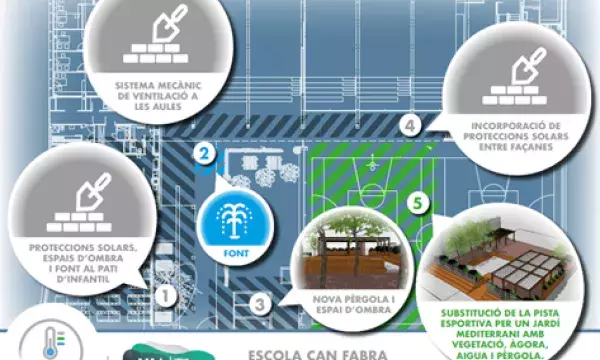
Image 9. Shading device at the upper part of the open space between the external shading surface and the school building (left and right: prior and after the intervention); see also point 4 at Image 8).
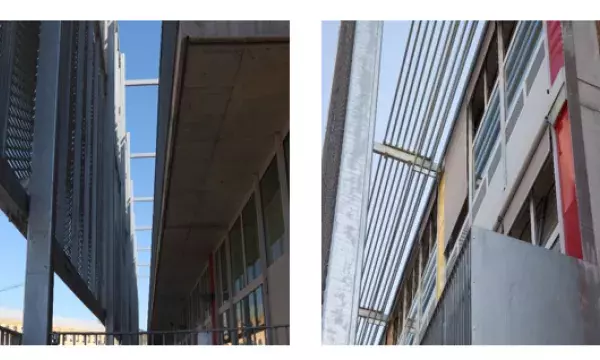
Image 10. New playground for students with pergola and shading device.
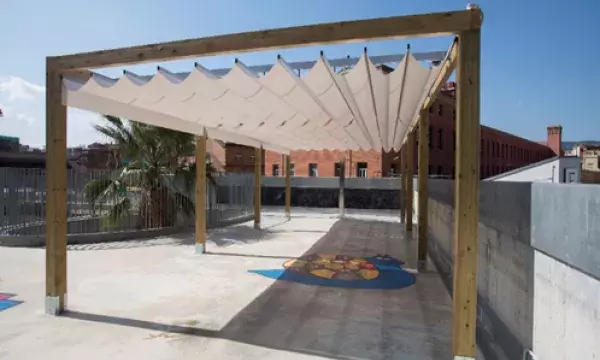
Case study 3 Els Llorers School
According to the performed analysis[10], the school is exposed to high values of incident solar radiation at the school yard (Image 11, right) with the majority of the open space covered with impermeable materials.
Image 11. View of the Els Llorers school (left) and estimate of the exposure to solar radiation (right); yellow and red colors refer to high values.
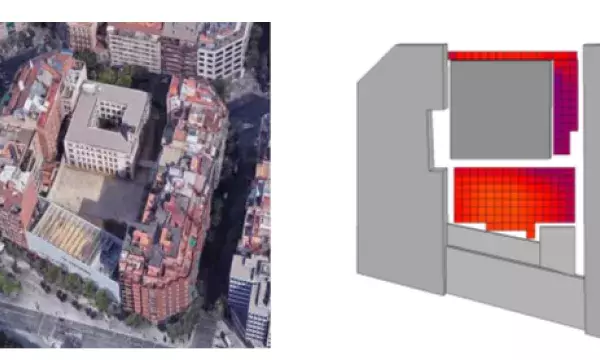
The design for the conversion of the school to Climate Shelter addressed a mix of interventions to reduce the temperature at the school yard, mostly through shading, greenery and blue infrastructure.
Image 12. Interventions to be implemented at Els Llorers School. 1: construction of new pergola; 2: modification of fountain; 3: reduction of existing sport yard; 4: creation of a garden 5: construction of a new pergola; 6: water games; 7: green reinforcement of fence; 8: fountain (Source: Barcelona City Council – Urban Ecology Area).
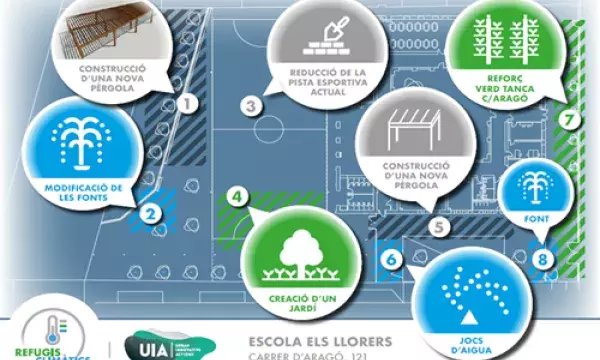
Special attention was given to the enhancement of greenery (a new garden and trees in the perimeter of the school yard) as well as to pergolas with removable awnings. In this way, temperature in the school yard is expected to drop, whereas sun shields will be deployed in the event of excessive heat.
Image 13. Pergola for the playground (top image; see also point 1 in Image 12), Mediterranean garden (middle image; see also point 4 in Image 12) and pergola with shading tent (bottom image; see also point 5 in Image 12).

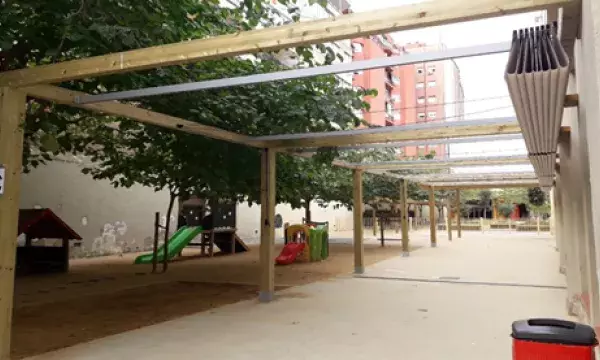
The day after
Adaptation planning can increase benefits and reduce risks associated with climate change impacts. Through proactive action, the City of Barcelona capitalized the potential of an innovative project funded by UIA.
Next steps in the project include (a) the evaluation of the interventions as far as their capacity to improve the local school/neighborhood environment is concerned and (b) the successful integration of Climate Shelters in city life, especially once the prevailing environmental conditions urge for their use. Furthermore, the need to develop and sustain maintenance schemes for the converted schools is central so as to secure the sustainability of the project’s results.
Finally, the upscaling of the project is besides a contractual obligation, a much needed step for extending the project to more schools and city areas. In this way, the project will succeed to further engage the school communities on the one hand and enhance the climate adaption potential of the Climate Shelters project on the other.
All images in this Web Article were provided by the Communication Team of the Climate Shelters project unless referred otherwise.
[1] https://www.uia-initiative.eu/en/news/barcelonas-pilot-project-beat-heat-0
[2] https://www.uia-initiative.eu/en/news/barcelonas-climate-shelters-project-challenge-communicating-unwelcome-messages-climate-change
[3] https://www.uia-initiative.eu/en/news/science-city
[4] https://www.uia-initiative.eu/en/news/adapting-barcelona-climate-change-multicriteria-approach-selection-schools-be-converted
[5] Barcelona Climate Plan
[6] Technical Procurement Document, 2020. CEB.
[7] https://www.barcelona.cat/barcelona-pel-clima/en/climate-shelters-schools
[8],[9],[10] Technical Procurement Document, 2020, CEB.
About this resource
The Urban Innovative Actions (UIA) is a European Union initiative that provided funding to urban areas across Europe to test new and unproven solutions to urban challenges. The initiative had a total ERDF budget of €372 million for 2014-2020.
Similar content




